Harman Kardon AVR-3550 Service manual
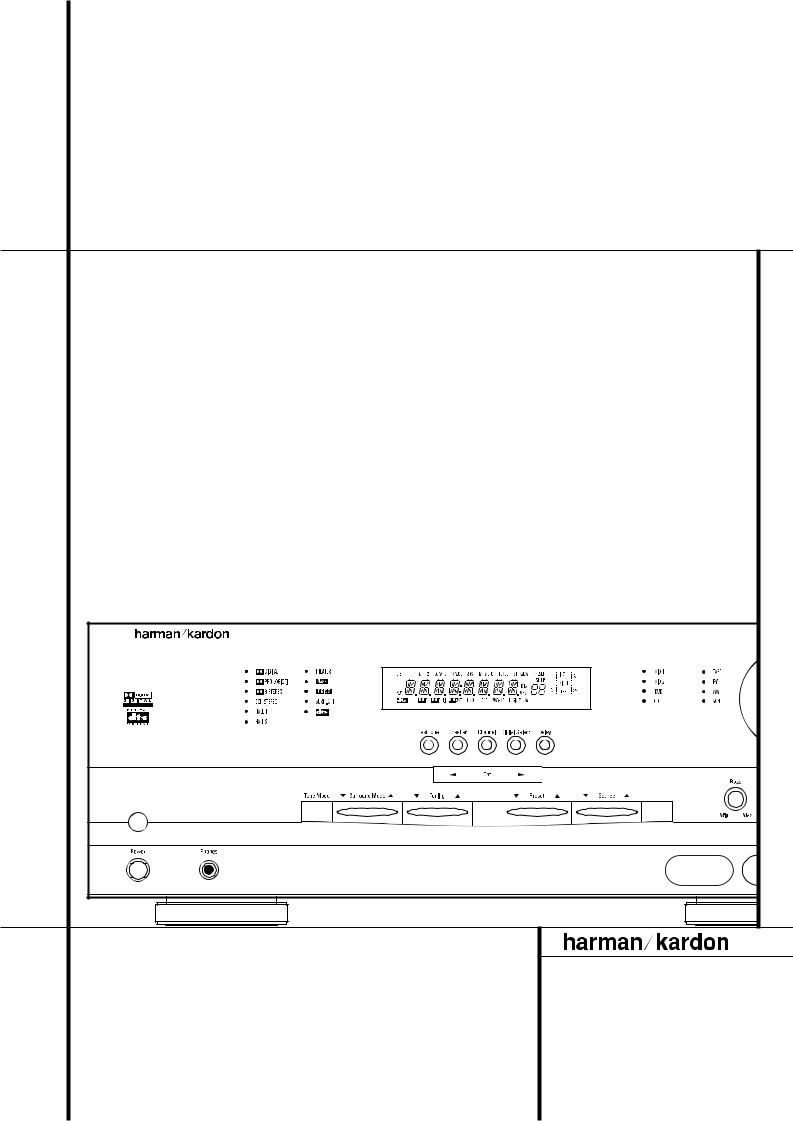
AVR 3550 Audio/Video Receiver |
|
OWNER’S MANUAL |
|
AVR 3550 |
|
AM/FM |
RDS |
|
® |
|
Power for the Digital Revolution™ |

Table of Contents
3Introduction
4Safety Information
4Unpacking
5Front Panel Controls
7 Front Panel Information Display
9 Rear Panel Connections
11 Remote Control Functions
14 Installation and Connections
14Audio Equipment Connections
14Video Equipment Connections
15SCART A/V Connections
16Remote Control Extension
16AC Power Connections
17Speaker Selection and Placement
18System Configuration
18First Turn On and Use of the OSD
18Settings to be Made With Each Input Used
19Input Setup
19 Surround Setup
19Adjustments for Other Inputs
20Making Settings independent of selected Input
20Speaker Setup
21Delay Settings
22Night Mode Settings
22Output Level Adjustment
22Using EzSet
23Manual Output Level Adjustment
25Operation
25Basic Operation
25Source Selection
25Controls and Use of Headphones
26Surround Mode Chart
27Surround Mode Selection
27Digital Audio Playback
28Selecting a Digital Source
28Digital Status Indicators
29Night Mode
29Tape Recording
30Output Level Trim Adjustment
306-Channel Direct Input
30Memory Backup
31Tuner Operation
32RDS Operation
33Advanced Features
33Display Brightness
33Turn-On Volume Level
34Semi OSD Settings
34Full-OSD Time Out Adjustment
35Programming the Remote
35Programming the Remote with Codes
35Macro Programming
36Programmed Device Function
36Volume Punch-Through
37Channel Control Punch-Through
37Transport Control Punch-Through
37Resetting the Remote Memory
38Function List
40Troubleshooting Guide
40Processor Reset
41Technical Specifications
Declaration of Conformity
We, Harman Consumer International
2, route de Tours
72500 Château-du-Loir,
FRANCE
declare in own responsibility, that the product described in this owner’s manual is in compliance with technical standards:
EN 55013/6.1990
EN 55020/12.1994
EN 60065:1993
EN 61000-3-2/4.1995
Carsten Olesen
Harman Kardon Europe A/S
03/02
Typographical Conventions
In order to help you use this manual with the remote control, front-panel controls and rear-panel connections, certain conventions have been used.
EXAMPLE – (bold type) indicates a specific remote control or front-panel button, or rear-panel connection jack
EXAMPLE – (OCR type) indicates a message that is visible on the front-panel information display
1– (number in a square) indicates a specific front-panel control
– (number in a circle) indicates a rear-panel connection
0– (number in an oval) indicates a button or indicator on the remote
A– (letter in a square) indicates an indicator in the front-panel display
2 TABLE OF CONTENTS
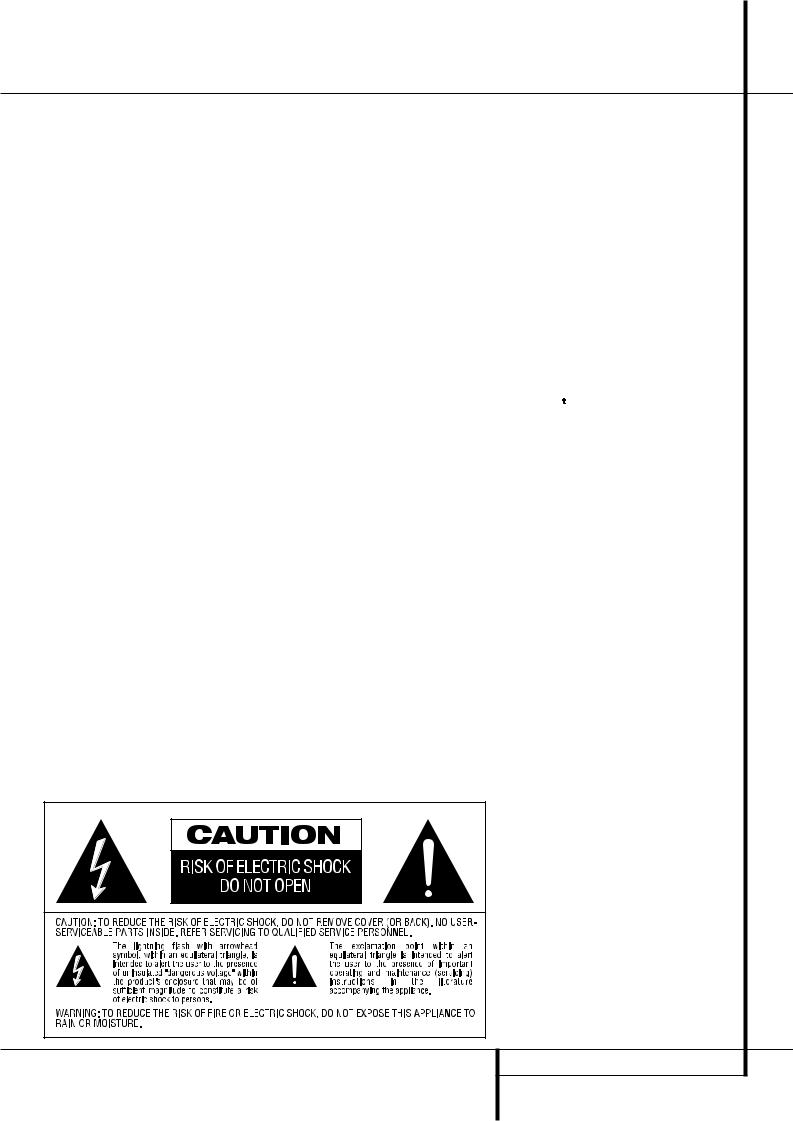
Introduction
Thank you for choosing Harman Kardon!
With the purchase of a Harman Kardon
AVR 3550 you are about to begin many years of listening enjoyment. The AVR 3550 has been custom designed to provide all the excitement and detail of movie sound tracks and every nuance of musical selections. With onboard Dolby* Digital and DTS† decoding, the AVR 3550 delivers six discrete channels of audio that take advantage of the digital sound tracks from the latest DVD and LD releases and Digital Television broadcasts.
While complex digital systems are hard at work within the AVR 3550 to make all of this happen, hookup and operation are simple. Color-keyed connections, programmable remote control, and on-screen menus make the AVR 3550 easy to use. To obtain the maximum enjoyment from your new receiver, we urge you to take the time to read through this manual. This will ensure that connections to speakers, source playback units and other external devices are made properly. In addition, a few minutes spent learning the functions of the various controls will enable you to take advantage of all the power the
AVR 3550 is able to deliver.
If you have any questions about this product, its installation or its operation, please contact your dealer. He is your best local source of information.
Description and Features
The AVR 3550 is among the most versatile and multi-featured A/V receivers available, incorporating a wide range of listening options. In addition to Dolby Digital and DTS decoding for digital sources, a broad choice of analog surround modes are available for use with sources such as CD, VCR, TV broadcasts and the AVR’s own FM/AM tuner. Along with the latest Dolby ProLogic® II decoding technology, Dolby 3 Stereo, 5 Ch Stereo and custom Hall and Theater modes, only Harman Kardon receivers offer Logic 7® to create a wider, more enveloping field environment and more defined fly-overs and pans.
Another Harman Kardon exclusive is VMAx™, which uses proprietary processing to create an open, spacious sound field even when only two front speakers are available.
In addition to providing a wide range of listening options, the AVR 3550 is easy to configure so that it provides the best results with your speakers and specific listening-room environment. On-screen menus make it simple to enter settings for speakers, inputs and delay times, while our exclusive EzSet™ remote measures a system‘s sound levels and automatically calibrates them for perfectly balanced soundfield presentation.
For the ultimate in flexibility, the AVR 3550 features connections for three video devices, all with both composite and S-Video inputs. Two additional audio inputs are available, and a total of four digital inputs make the AVR 3550 capable of handling all the latest digital audio sources. Coax and optical digital outputs are available for direct connection to digital recorders. A video recording output, and a sixchannel input make the AVR 3550 virtually future-proof, with everything needed to accommodate tomorrow’s new formats right on board.
The AVR 3550’s powerful amplifier uses traditional Harman Kardon high-current design technologies to meet the wide dynamic range of any program selection.
Harman Kardon invented the high-fidelity receiver more than forty-nine years ago. With state-of- the-art circuitry and time-honored circuit designs, the AVR 3550 is one of the finest receivers ever offered by Harman Kardon within its price range.
■Onboard Dolby Digital and DTS Decoding Using Crystal® Chip Technology
■Harman Kardon’s Exclusive Logic 7 and VMAx Modes
■Dolby Laboratory's latest ProLogic II decoding technology.
■




 TM Remote Automatically Sets Output Levels for Optimum Performance
TM Remote Automatically Sets Output Levels for Optimum Performance
■Multiple Digital Inputs and Outputs
■On-Screen Menu and Display System
■6-Channel direct input for use with SACD or DVD-Audio players, other products with internal surround decoders or external surround decoders.
■Remote with Internal Codes Capability
INTRODUCTION 3

Safety Information
Important Safety Information
Verify Line Voltage Before Use
Your AVR 3550 has been designed for use with 220-240-Volt AC current. Connection to a line voltage other than that for which it is intended can create a safety and fire hazard and may damage the unit.
If you have any questions about the voltage requirements for your specific model, or about the line voltage in your area, contact your dealer before plugging the unit into a wall outlet.
Do Not Use Extension Cords
To avoid safety hazards, use only the power cord attached to your unit. We do not recommend that extension cords be used with this product. As with all electrical devices, do not run power cords under rugs or carpets or place heavy objects on them. Damaged power cords should be replaced immediately by an authorized service depot with a cord meeting factory specifications.
Handle the AC Power Cord Gently
When disconnecting the power cord from an AC outlet, always pull the plug, never pull the cord. If you do not intend to use the unit for any considerable length of time, disconnect the plug from the AC outlet.
Do Not Open the Cabinet
There are no user-serviceable components inside this product. Opening the cabinet may present a shock hazard, and any modification to the product will void your guarantee. If water or any metal object such as a paper clip, wire or a staple accidentally falls inside the unit, disconnect it from the AC power source immediately, and consult an authorized service station.
Installation Location
■To assure proper operation and to avoid the potential for safety hazards, place the unit on a firm and level surface. When placing the unit on a shelf, be certain that the shelf and any mounting hardware can support the weight of the product.
■Make certain that proper space is provided both above and below the unit for ventilation. If this product will be installed in a cabinet or other enclosed area, make certain that there is sufficient air movement within the cabinet. Under some circumstances a fan may be required.
■Do not place the unit directly on a carpeted surface.
■Avoid installation in extremely hot or cold locations, or an area that is exposed to direct sunlight or heating equipment.
■Avoid moist or humid locations.
■Do not obstruct the ventilation slots on the top of the unit, or place objects directly over them.
Cleaning
When the unit gets dirty, wipe it with a clean, soft, dry cloth. If necessary, wipe it with a soft cloth dampened with mild soapy water, then a fresh cloth with clean water. Wipe dry immediately with a dry cloth. NEVER use benzene, aerosol cleaners, thinner, alcohol or any other volatile cleaning agent. Do not use abrasive cleaners, as they may damage the finish of metal parts. Avoid spraying insecticide near the unit.
Moving the Unit
Before moving the unit, be certain to disconnect any interconnection cords with other components, and make certain that you disconnect the unit from the AC outlet.
Unpacking
The carton and shipping materials used to protect your new receiver during shipment were specially designed to cushion it from shock and vibration. We suggest that you save the carton and packing materials for use in shipping if you move, or should the unit ever need repair.
To minimize the size of the carton in storage, you may wish to flatten it. This is done by carefully slitting the tape seams on the bottom and collapsing the carton. Other cardboard inserts may be stored in the same manner. Packing materials that cannot be collapsed should be saved along with the carton in a plastic bag.
If you do not wish to save the packaging materials, please note that the carton and other sections of the shipping protection are recyclable. Please respect the environment and discard those materials at a local recycling center.
4 SAFETY INFORMATION
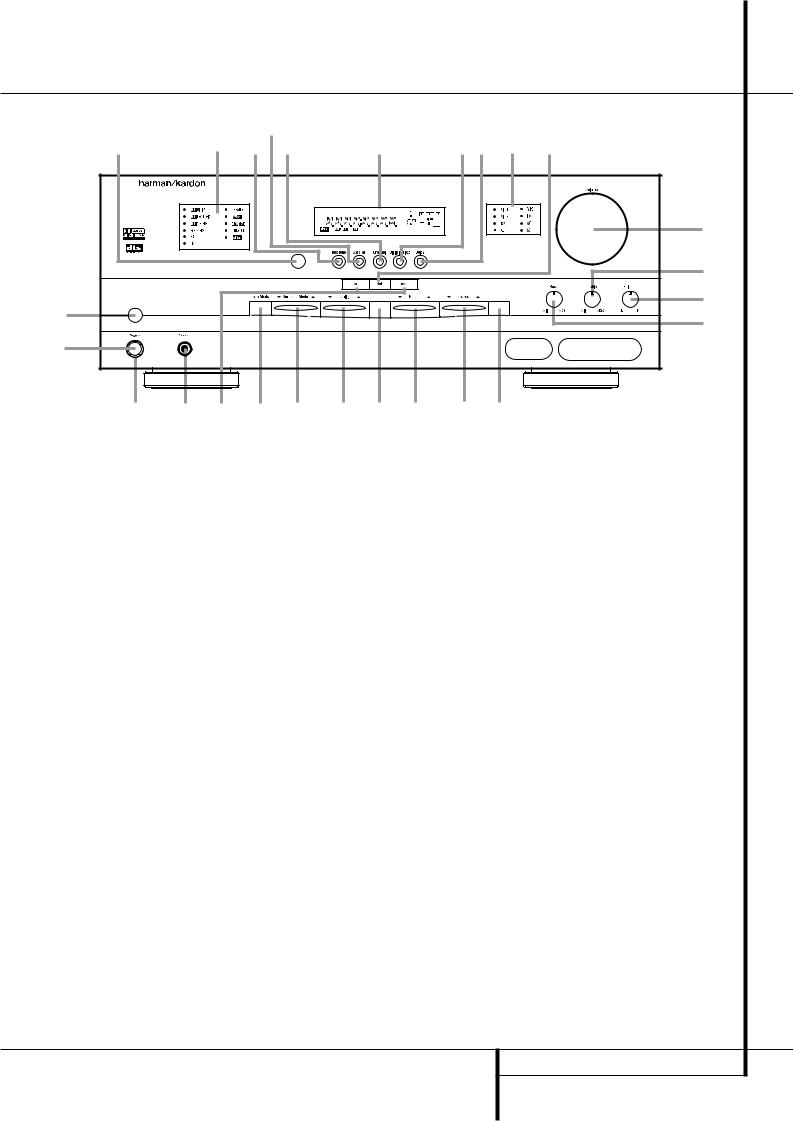
Front Panel Controls
|
|
Ù |
|
|
|
|
|
|
|
|
% |
$ # Û |
|
|
Ú |
|
|
|
Ò Ô Ó |
|
|
|
AVR 3550 |
|
|
|
|
|
|
|
|
|
|
II |
DTS |
OPT12 |
COAX12 |
ANALOG RDS TA AUTO TUNED |
ST MEM |
|
|
|
|
|
HDCD |
|
|
|
KHz |
SL |
SR |
|
|
|
|
|
PCM |
|
|
|
|
( |
|||
|
|
|
|
|
MHz |
|
|
|
||
|
|
|
|
PL II |
3ST OSD DSP VMAx NF |
LOGIC 7 CM |
MULTI SBL |
SBR |
|
|
|
|
|
|
|
|
|
|
|
|
|
|
2 |
|
|
|
|
|
|
|
|
|
|
|
|
|
|
|
|
|
|
|
* |
|
|
|
|
|
AM/FM |
|
|
|
RDS |
& |
|
|
|
|
|
|
|
|
|
|
|
1 |
|
|
|
|
|
|
|
|
|
^ |
|
|
|
|
|
|
|
|
|
|
|
2 |
|
|
|
|
|
|
|
|
|
|
3 |
4 5 |
6 7 |
8 9 ) |
|
! @ |
|
||||
1 Main Power Switch
2 System Power Control
3 Power Indicator
4 Headphone Jack
5 Selector Buttons
6 Tone Mode
7 Surround Mode Selector
8 Tuning
9 Tuner Band Selector
)Preset Stations Selector
1Main Power Switch: Press this button to apply power to the AVR. When the switch is pressed in, the unit is placed in a Standby mode, as indicated by the orange LED 3surrounding the System Power Control 2. This button MUST be pressed in to operate the unit. To turn the unit off completely and prevent the use of the remote control, this switch should be pressed until it pops out from the front panel so that the word “OFF” may be read at the top of the switch.
NOTE: This switch is normally left in the “ON” position.
!Input Source Selector
@RDS Select Button
#Test Tone Selector
$Surround Mode Indicators
%Remote Sensor Window
^Bass Control
&Balance Control
*Treble Control
(Volume Control
ÓSet Button
2System Power Control: When the Main Power Switch 1is “ON,”press this button to turn on the AVR; press it again to turn the unit off (to Standby). Note that the Power Indicator surrounding the switch 3will turn green when the unit is on.
3Power Indicator: This LED will be illuminated in orange when the unit is in the Standby mode to signal that the unit is ready to be turned on. When the unit is in operation, the indicator will turn green.
4Headphone Jack: This jack may be used to listen to the AVR’s output through a pair of headphones. Be certain that the headphones have a standard 6.3 mm stereo phone plug. Note that the speakers will automatically be turned off when the headphones are connected.
ÔInput Indicators
Delay
ÒDigital Input Selector
ÚMain Information Display
ÛChannel Select Button
ÙSpeaker Select Button
5Selector Buttons: When you are establishing the AVR’s configuration settings, use these buttons to select from the choices available, as shown in the Main Information Display Ú.
6Tone Mode: Pressing this button enables or disables the Balance, Bass and Treble tone controls. When the button is pressed so that the words TONE IN appear in the Main Information Display Ú, the settings of the
Bass ^and Treble *controls and of the Balance control &will affect the output signals. When the button is pressed so that the words TONE OUT appear in the Main Information Display Ú, the output signal will be “flat,”without any balance, bass or treble alteration.
FRONT PANEL CONTROLS 5

Front Panel Controls
7Surround Mode Selector: Press this button to change the surround mode by scrolling through the list of available modes. Note that Dolby Digital and DTS modes can be selected only when a digital input is used (See page 26 for more information about surround modes.)
8Tuning Selector: Press the left side of the button to tune lower frequency stations and the right side of the button to tune higher frequency stations. When a station with a strong signal is reached, the TUNED indicator Lwill illuminate in the Main Information Display Ú(see page 31 for more information on tuning stations).
9Tuner Band Selector: Pressing this button will automatically switch the AVR to the Tuner mode. Pressing it again will switch between the AM and FM frequency bands, holding it pressed for some seconds will switch between stereo and mono receiving and between automatic and manual tuning mode (See page 31 for more information on the tuner).
)Preset Stations Selector: Press this button to scroll up or down through the list of stations that have been entered into the preset memory. (See page 31 for more information on tuner programming.)
!Input Source Selector: Press this button to change the input by scrolling through the list of input sources.
@RDS Select Button: Press this button to display the various messages that are part of the RDS data system of the AVR’s tuner. (See page 32 for more information on RDS).
#Test Tone Selector: Press this button to begin the process of adjusting the channel output levels using the internal test tone as a reference. (For more information on output level adjustment, see page 22.)
$Surround Mode Indicators: A green LED will light in front of the surround mode that is currently in use.
%Remote Sensor Window: The sensor behind this window receives infrared signals from the remote control. Aim the remote at this area and do not block or cover it unless an external remote sensor is installed.
^Bass Control: Turn this control to modify the low frequency output of the left/right channels by as much as ±10dB. Set this control to a suitable position for your taste or room acoustics.
&Balance Control: Turn this control to change the relative volume for the front left/right channels.
NOTE: For proper operation of the surround modes this control should be at the midpoint or “12 o’clock” position.
*Treble Control: Turn this control to modify the high frequency output of the left/right channels by as much as ±10dB. Set this control to a suitable position for your taste or room acoustics.
(Volume Control: Turn this knob clockwise to increase the volume, counterclockwise to decrease the volume. If the AVR is muted, adjusting volume control will automatically release the unit from the silenced condition.
ÓSet Button: When making choices during the setup and configuration process, press this button to enter the desired setting as shown in the Main Information Display Úinto the AVR’s memory. The set button may also be used to change the display brightness. (See page 33).
ÔInput indicators: A green LED will light in front of the input that is currently being used as the source for the AVR.
Delay: Press this button to begin the sequence of steps required to enter delay time settings. (See page 21 for more information on delay times.)
ÒDigital Input Selector: When playing a source that has a digital output, press this button to select between the Optical and Coaxial Digital inputs. (See pages 27-29 for more information on digital audio.)
Ú Main Information Display: This display delivers messages and status indications to help you operate the receiver. (See pages 7–8 for a complete explanation of the Information Display.)
ÛChannel Select Button: Press this button to begin the process of trimming the channel output levels using an external audio source. (For more information on output level trim adjustment, see page 30.)
ÙSpeaker Select Button: Press this button to begin the process of selecting the speaker positions that are used in your listening room. (See page 18 for more information on setup and configuration.)
6 FRONT PANEL CONTROLS
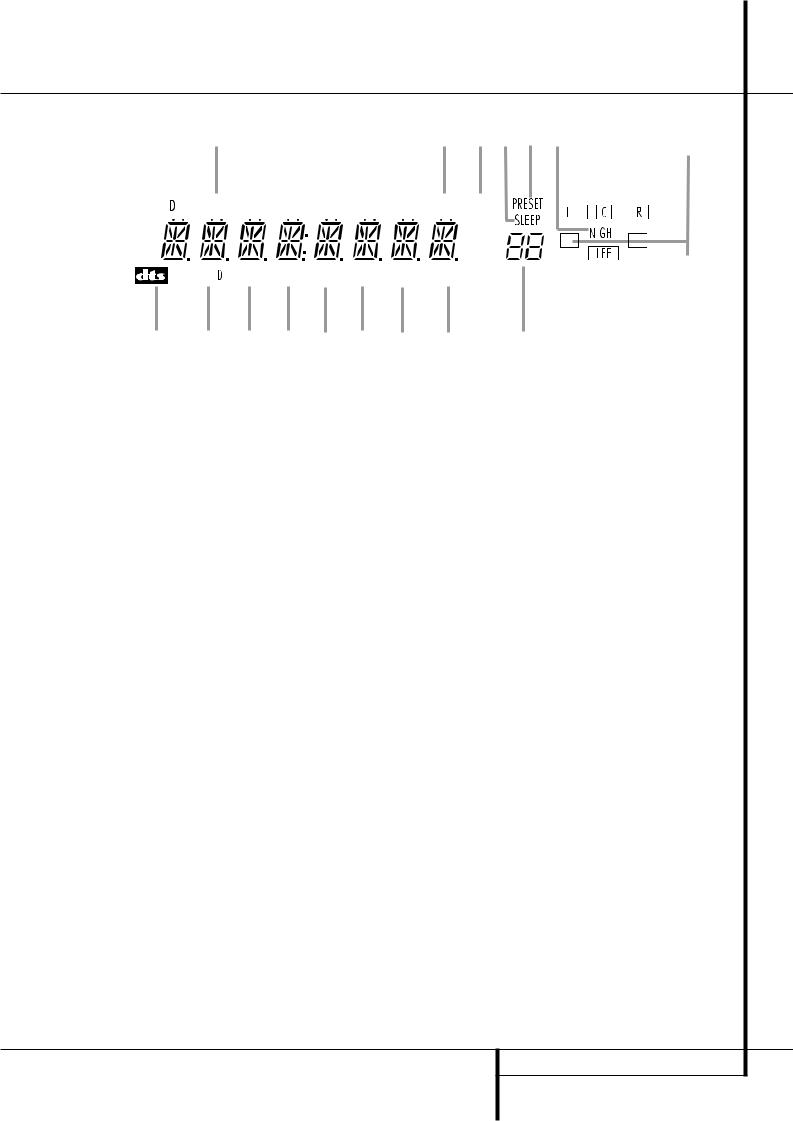
Front Panel Information Display
|
|
|
|
|
|
|
|
|
B E GNWXPL V UTSO |
Q |
||||||||||||||||||||||||||
|
|
|
|
|
|
|
|
|
|
|
|
|
|
|
|
|
|
|
|
|
|
|
|
|
|
|
|
|
|
|
|
|
|
|
||
|
|
|
|
|
|
|
|
|
|
|
|
|
|
|
|
|
|
|
|
|
|
|
|
|
|
|
|
|||||||||
|
|
|
|
|
|
|
|
|
|
|
|
|
|
|
|
|
|
|
|
|
|
|
|
|
|
|
|
|
|
|
|
|
|
|
|
|
A |
|
|
|
DTS |
|
|
OPT12 COAX12 |
ANALOG |
RDS TA AUTO TUNED ST MEM |
|
|
|
|
|
|
|||||||||||||||||||||
|
|
|
|
|
|
|
|
|
|
|
||||||||||||||||||||||||||
|
|
|
|
|
|
|
|
|
|
|
|
|
|
|
|
|
|
|
|
|
KHz |
SL |
|
SR |
|
|
||||||||||
|
|
|
|
|
|
|
|
|
|
|
|
|
|
|
|
|
|
|
|
|
|
|
|
|||||||||||||
|
|
|
|
PCM |
|
|
|
|
|
|
|
|
|
|
|
|
|
|
||||||||||||||||||
|
|
|
|
|
|
|
|
|
|
|
|
|
|
|
|
|
|
|||||||||||||||||||
|
|
|
|
|
|
|
|
|
|
|
|
|
|
|
|
PL II |
|
|
|
3ST |
|
|
|
|
|
|
|
MHz |
|
|
|
|
|
|
||
|
|
|
|
|
|
|
|
|
|
|
|
|
|
|
|
|
|
|
|
|
|
|
|
|
||||||||||||
|
|
|
|
|
|
|
|
|
|
|
|
|
|
|
|
|
|
|
OSD DSP VMAx NF LOGIC 7 CM |
|
|
|
|
|
|
|||||||||||
|
|
|
|
|
|
|
|
|
|
|
|
|||||||||||||||||||||||||
|
|
|
|
|
|
|
|
|
|
|
|
|||||||||||||||||||||||||
|
|
|
|
|
|
|
|
|
|
|
|
|
|
|
|
|
|
|
|
|
|
|
|
|
|
|
|
|
|
|
|
|
|
|
|
|
C |
D F H M J I |
K |
R |
A Bitstream Indicators |
I VMAx Mode Indicator |
|
Q Speaker/Channel Input Indicators |
B Optical Source Indicators |
J DSP Mode Indicator |
|
R Preset Number/Sleep Timer |
C DTS Mode Indicator |
K Logic 7 Mode Indicators |
|
S Preset Indicator |
D Dolby Digital Indicator |
L Tuned Indicator |
|
T Sleep Indicator |
E Coaxial Digital Input Indicators |
M OSD Indicator |
|
U Memory Indicator |
F Dolby Pro Logic II Indicator |
N Main Information Display |
|
V Stereo Indicator |
G Analog Input Indicator |
O Night Mode Indicator |
|
W RDS Indicator |
H Dolby 3 Stereo Indicator |
P Auto Indicator |
|
X Traffic Program Indicator |
ABitstream™ Indicators: When the input is a digital source, one of these indicators will light to display the specific type of signal in use.
BOptical Source Indicators: These indicators light to show when a Optical Digital Input has been selected.
CDTS Mode Indicator: This indicator illuminates when the DTS mode is selected.
DDolby Digital Indicator: This indicator illuminates when Dolby Digital mode is selected.
ECoaxial Digital Input Indicators: These indicators light to show when a Coaxial Digital Input has been selected.
FDolby Pro Logic II Indicator: This indicator lights when the Dolby Pro Logic II mode has been selected.
GAnalog Input Indicator: This indicator lights when an analog input source has been selected.
HDolby 3 Stereo Indicator: This indicator lights when the Dolby 3 Stereo Mode has been selected. Only ST (Stereo) will light when ”Surround Off” has been selected. Then all Surround Modes are turned off and the unit will play in pure stereo mode.
IVMAx Mode Indicator: This indicator illuminates to show that the VMAx mode is in use. VMAx F appears when the Far Field VMAx mode is selected; VMAx N appears when the Near Field VMAx mode is selected. (See page 26 for a description of the VMAx Modes.)
JDSP Mode Indicator: This indicator lights when any of the surround modes created by Digital Signal Processing, or DSP are in use. These modes include Hall 1, Hall 2, Theater, Surround Off A/D-Mode and 5 Channel Stereo.
KLogic 7 Mode Indicators: These indicators illuminate when the Logic 7 mode is in use. LOGIC 7C appears for the Cinema version of Logic 7, LOGIC 7M appears for the Music version of Logic 7. (See page 26 for a description of the Logic 7 Modes.)
LTuned Indicator: This indicator illuminates when a station is being received with sufficient signal strength to provide acceptable listening quality.
MOSD Indicator: When the OSD system is in use, this indicator lights to remind you that the other indicators in this display do not function when the On Screen Display is being used.
NMain Information Display: This display shows messages relating to the status, input source, surround mode, tuner, volume level or other aspects of unit’s operation.
ONight Mode Indicator: This indicator lights when the AVR 3550 is in the Night mode, which preserves the dynamic range of digital program material at low volume levels.
PAuto Indicator: This indicator illuminates when the tuner’s Auto mode is in use.
QSpeaker/Channel Input Indicators: These indicators are multipurpose, indicating either the speaker type selected for each channel or the incoming data-signal configuration. The left, center, right, right surround and left surround speaker indicators are composed of three boxes, while the subwoofer is a single box. The center box lights when a “Small” speaker is selected, and the two outer boxes light when “Large” speakers are selected. When none of the boxes are lit for the center, surround or subwoofer channels, no speaker has been selected for that position. (See page 19 for more information on configuring speakers.) The letters inside each of the center boxes display active input channels. For standard analog inputs, only the L and R will light, indicating a stereo input. When a digital source is playing, the indicators will light to display the channels begin received at the digital input. When the letters flash, the digital input has been interrupted. (See page 29 for more information on the Channel Indicators).
RPreset Number/Sleep Timer: When the tuner is in use, these numbers indicate the specific preset memory location in use. (See page 31 for more information on preset stations.) When the Sleep function is in use, these numbers show how many minutes remain before the unit goes into the Standby mode.
FRONT PANEL INFORMATION DISPLAY 7

Front Panel Information Display
SPreset Indicator: This indicator lights when the tuner is in use to show that the Preset Number/Sleep Timer Ris showing the station’s preset memory number. (See page 31 for more information on tuner presets).
TSleep Indicator: This indicator lights when the Sleep function is in use. The numbers in the Preset/Sleep Number Indicators will show the minutes remaining before the AVR goes into the Standby mode. (See page 25 for more information on the Sleep function).
UMemory Indicator: This indicator flashes when entering presets and other information into the tuner’s memory.
VStereo Indicator: This indicator illuminates when an FM station is being tuned in stereo.
WRDS Indicator: This indicator illuminates when the station tuned is transmitting RDS data.
XTraffic Program Indicator: This indicator illuminates if the RDS station tuned sometimes transmits traffic information (see page 32 for more information on RDS).
8 FRONT PANEL INFORMATION DISPLAY
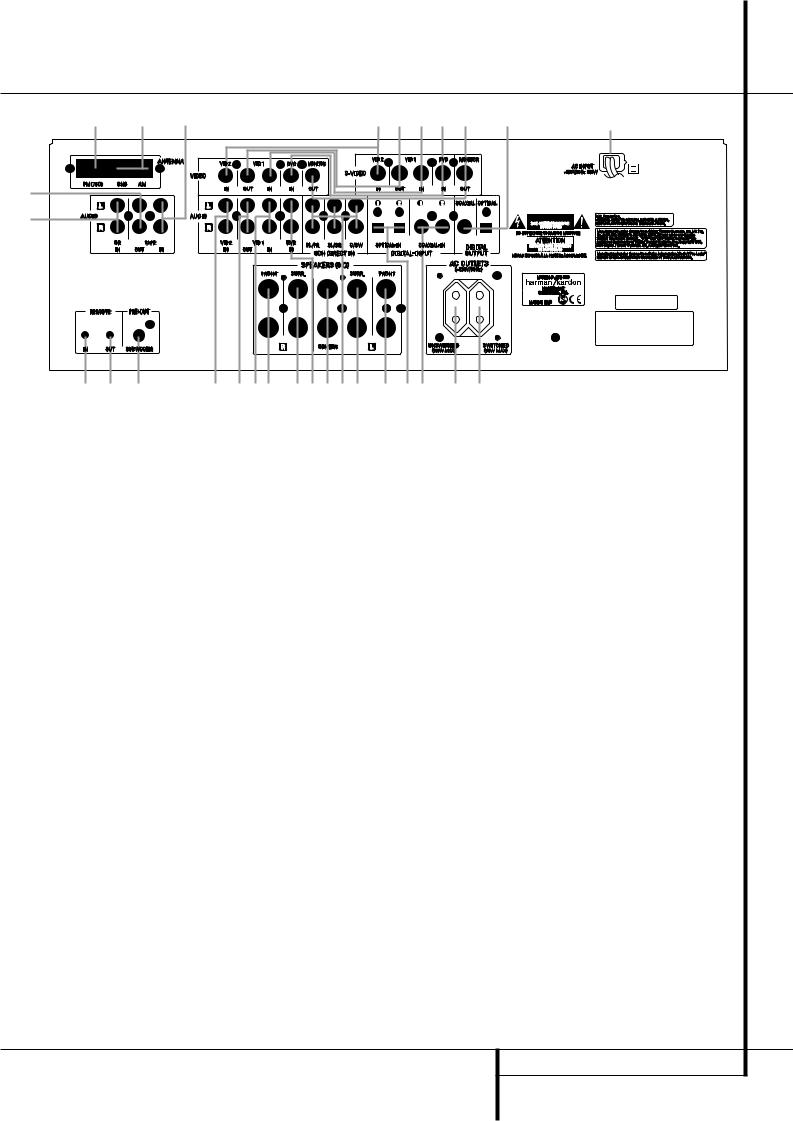
Rear Panel Connections
¶ |
¢ |
¡ |
c a e · ‹ |
‚ |
° |
|
|
|
|
|
|
™ |
|
|
|
|
|
• |
|
|
|
|
|
b d ¤ |
|
g ∞ £ › fi § › ª fi › f ⁄ ‡ fl |
|
|
|
Tape Inputs |
Coaxial Digital Inputs |
Remote IR Input |
Tape Outputs |
Subwoofer Output |
Video 2 Video Inputs |
Video 1 Audio Inputs |
Video Monitor Outputs |
Remote IR Output |
AM Antenna |
Front/Center Speaker Outputs |
Video 1 Video Inputs |
Video 1 Audio Outputs |
Surround Speaker Outputs |
Optical Digital Inputs |
DVD Audio Inputs |
Switched AC Accessory Outlet |
Video 2 Audio Inputs |
FM Antenna |
Unswitched AC Accessory Outlet |
|
CD Inputs |
AC Power Cord |
|
6-Channel Direct Inputs |
DVD Video Inputs |
|
Digital Audio Outputs |
Video 1 Video Outputs |
|
Tape Inputs: Connect these jacks to the PLAY/OUT jacks of an audio recorder.
Tape Outputs: Connect these jacks to the RECORD/INPUT jacks of an audio recorder.
Video 1 Audio Inputs: Connect these jacks to the PLAY/OUT audio jacks on a VCR or other video source.
AM Antenna: Connect the AM loop antenna supplied with the receiver to these terminals. If an external AM antenna is used, make connections to the AM and GND terminals in accordance with the instructions supplied with the antenna.
Video 1 Audio Outputs: Connect these jacks to the RECORD/INPUT audio jacks on a VCR or any other Audio recorder.
DVD Audio Inputs: Connect these jacks to the analog audio jacks on a DVD or other video source.
FM Antenna: Connect the supplied indoor or an optional external FM antenna to this terminal.
CD Inputs: Connect these jacks to the analog output of a compact disc player or CD changer.
6-Channel Direct Inputs: If an external digital audio decoder is used, connect the outputs of that decoder to these jacks.
Digital Audio Outputs: Connect these jacks to the matching digital input connector on a digital recorder such as a CD-R or MiniDisc recorder.
Coaxial Digital Inputs: Connect the coax digital output from a DVD player, HDTV receiver, LD player, MD player or CD player to these jacks. The signal may be either a Dolby Digital signal, DTS signal or a standard PCM digital source. Do not connect the RF digital output of an LD player to these jacks.
Subwoofer Output: Connect this jack to the line-level input of a powered subwoofer. If an external subwoofer amplifier is used, connect this jack to the subwoofer amplifier input.
REAR PANEL CONNECTIONS 9

Rear Panel Connections
Video Monitor Outputs: Connect these jacks to the composite and/or S-Video input of a TV monitor or video projector to view the onscreen menus and the output of any video source selected by the receiver’s video switcher.
Front/Center Speaker Outputs: Connect these outputs to the matching + or – terminals on your front/center speakers. When making speaker connections, always make certain to maintain correct polarity by connecting the red
(+) terminals on the AVR to the red (+) terminals on the speaker and the black (–) terminals on the AVR to the black (–) terminals on the speakers. (See page 14 for more information on speaker polarity.)
Surround Speaker Outputs: Connect these outputs to the matching + or – terminals on your left and right surround speakers. When making speaker connections always make certain to maintain correct polarity by connecting the red (+) terminals on the AVR to the red (+) terminals on the speakers and the black (–) terminals on the AVR to the black (–) terminals on the speakers. See page 14 for more information on speaker polarity.
Switched AC Accessory Outlet: This outlet may be used to power any device that you wish to have turn on when the unit is turned on with the System Power Control switch 2.
Unswitched AC Accessory Outlet: This outlet may be used to power any AC device. The power will remain on at this outlet regardless of whether the AVR is on or off (in Standby), provided that the Main Power switch 1is on.
Note: The total power consumption of all devices connected to the accessory outlets should not exceed 100 watts from the
Unswitched Outlet and 50 W from the Switched Outlet .
AC Power Cord: Connect the AC plug to an unswitched AC wall output.
DVD Video Inputs: Connect these jacks to the composite or S-Video output jacks on a DVD player or other video source.
Video 1 Video Outputs: Connect these jacks to the RECORD/INPUT composite or S-Video jack on a VCR.
Remote IR Input: If the receivers frontpanel IR sensor is blocked due to cabinet doors or other obstructions, an external IR sensor may be used. Connect the output of the sensor to this jack.
Video 2 Video Inputs: Connect these jacks to the PLAY/OUT composite or S-Video jacks on a second VCR or other video source.
Remote IR Output: This connection permits the IR sensor in the receiver to serve other remote controlled devices. Connect this jack to the “IR IN” jack on Harman Kardon or other compatible equipment.
Video 1 Video Inputs: Connect these jacks to the PLAY/OUT composite or S-Video jacks on a VCR or other video source.
Optical Digital Inputs: Connect the optical digital output from a DVD player, HDTV receiver, LD player, MD player or CD player to these jacks. The signal may be either a Dolby Digital signal, a DTS signal or a standard PCM digital source.
Video 2 Audio Inputs: Connect these jacks to the PLAY/OUT audio jacks on a VCR or other video source.
Note: Either the Video or S-Video output of any S-Video source must be connected to the AVR, not both in parallel, otherwise the video may be disturbed or its performance be adversely effected.
10 REAR PANEL CONNECTIONS
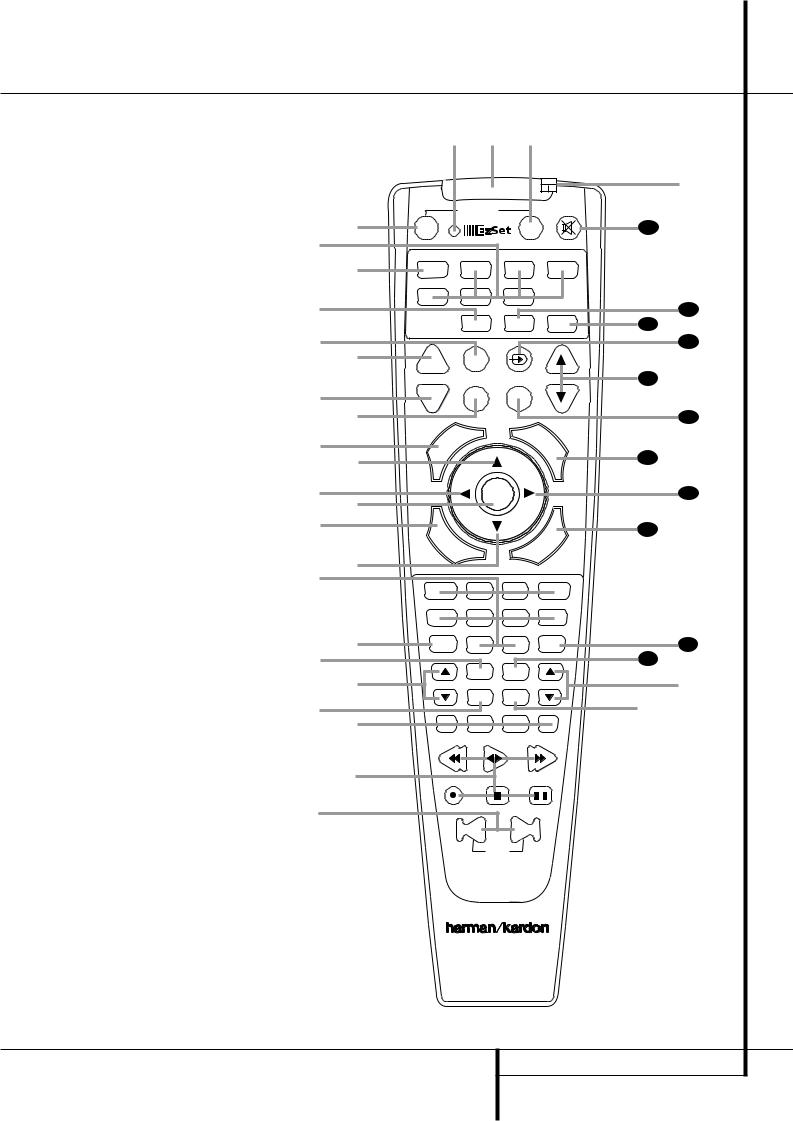
Remote Control Functions
0Power On Button
1IR Transmitter Window
2Program/SPL Indicator
3Power Off Button
4Input Selectors
5AVR Selector
6AM/FM Tuner Select
7EzSet Sensor Microphone
8Test Button
9Sleep Button
ASurround Mode Selector
BNight Mode
CChannel Select Button
D⁄/ ¤ Buttons
E‹ Button
FSet Button
GDigital Select
HNumeric Keys
ITuner Mode
JDirect Button
KTuning Up/Down
LOSD Button
MMacro Buttons
NTransport Controls
OSkip Up/Down Buttons
PRDS Select Button
QPreset Up/Down
Clear Button
Memory Button
Delay/Prev. Ch.
›Button !Speaker Select "Spare Button
#Volume Up/Down $TV/Video Selector %SPL Indicator Select &6-Channel Direct Input 'Mute
NOTE: The function names shown here are each button’s feature when used with the AVR. Most buttons have additional functions when used with other devices. See page 38-39 for a list of these functions.
c b d
|
|
|
|
POWER |
|
|
|
|
|
|
|
|
|
|
|
a |
ON |
|
|
TM |
OFF |
|
|
|
|
|
|
|
|
||
e |
|
|
|
|
|
|
|
|
|
|
|
|
|
|
|
f |
AVR |
|
DVD |
CD |
|
|
|
|
TAPE |
||||||
|
V C R |
|
T V |
CBL/SAT |
|
|
|
|
|
|
|
|
|||
g |
VID1 |
|
VID2 |
|
|
|
|
|
|
|
|
|
|
|
|
|
|
|
|
|
|
|
|
|
|
|
|
|
|
|
|
|
|
|
|
AM/FM |
6 CH. |
|
|
|
|
|
SPL |
||||
i |
|
|
|
|
|
|
|
|
|
|
|
|
|
|
|
j |
SLEEP |
|
TEST |
|
|
|
|
|
|
|
|
|
|
|
|
|
|
|
|
|
|
|
|
|
|
|
|
|
|
||
|
CH. |
|
NIGHT |
|
|
|
|
|
|
VOL. |
|||||
k |
SURR. |
|
|
|
|
|
|
|
|
|
|
|
|
|
|
|
|
|
|
|
|
|
|
|
|
|
|
|
|
|
|
l |
|
|
|
|
|
|
|
|
M |
|
|
|
|
||
|
|
|
|
|
|
|
|
|
|
|
|
|
|||
|
|
E |
|
|
|
|
|
|
|
|
E |
|
|
|
|
|
|
|
|
|
|
|
|
|
|
N |
|
||||
|
ID |
|
|
|
|
|
|
|
|
|
|
U |
|
||
|
U |
|
|
|
|
|
P |
|
|
|
|
|
|||
m |
G . |
|
|
|
S |
K |
|
|
|
|
|
|
|||
|
C |
H |
|
|
|
|
R |
|
|
|
|
||||
|
|
|
|
|
|
|
|
|
|
|
|||||
n |
|
|
|
|
|
|
|
|
|
|
|
|
|
|
|
o p |
|
|
|
SET |
|
|
|
|
|
|
|
|
|
|
|
|
|
|
|
|
|
|
|
|
|
|
|
|
|
||
q |
|
D |
|
|
|
|
|
|
|
|
|
|
|
|
|
|
|
I |
|
|
|
|
|
|
|
|
Y |
|
|
|
|
|
|
I |
|
|
|
|
|
|
|
|
|
|
|
||
|
|
G |
|
|
|
|
|
|
|
A |
|
|
|
|
|
|
E |
T |
|
|
|
|
|
|
|
|
|
|
|||
|
I |
A |
|
|
|
|
E |
|
|
|
|
|
H |
||
|
L |
|
|
|
D |
|
|
|
|
|
|
||||
|
X |
|
|
|
|
|
|
|
|
|
|
|
.C |
|
|
|
T |
|
|
|
|
|
|
|
|
|
|
|
|
||
|
|
|
|
|
|
|
|
|
|
|
|
|
V |
|
|
n |
|
|
|
|
|
|
|
|
|
|
|
E |
|
|
|
|
|
|
|
|
|
|
|
|
|
R |
|
|
|
||
|
|
|
|
|
|
|
|
|
P |
|
|
|
|
||
r |
|
1 |
|
2 |
3 |
|
|
|
|
|
4 |
|
|
|
|
|
|
|
|
|
|
|
|
|
|
|
|||||
|
|
5 |
|
6 |
7 |
|
|
|
|
8 |
|
|
|
|
|
s |
|
TUN-M |
9 |
0 |
|
|
MEM |
|
|
||||||
|
|
|
|
|
|
|
|
||||||||
t |
|
|
|
|
|
|
|
|
|
|
|
|
|
|
|
u |
|
|
|
DIRECT |
CLEAR |
|
|
|
|
|
|
|
|
|
|
|
TUNING |
|
|
|
PRESET |
|
|||||||||
|
|
|
|
|
|
||||||||||
|
|
|
|
OSD |
RDS |
|
|
|
|
|
|
|
|
|
|
v |
|
|
|
|
|
|
|
|
|
|
|
|
|
|
|
w |
|
M1 |
M2 |
M3 |
|
|
M4 |
|
|
|
|
||||
|
|
|
|
|
|
|
|
||||||||
x |
|
|
|
|
|
|
|
|
|
|
|
|
|
|
|
y |
|
|
|
|
|
|
|
|
|
|
|
|
|
|
|
|
|
|
|
DWN |
UP |
|
|
|
|
|
|
|
|
|
|
|
|
|
|
SKIP |
|
|
|
|
|
|
|
|
|
|
|

 3550
3550
h
38
37
36
35
34
33
32
31
30
29
28
`
z
REMOTE CONTROL FUNCTIONS 11

Remote Control Functions
IMPORTANT NOTE: The AVR 3550’s remote may be programmed to control up to seven devices, including the AVR 3550. Before using the remote, it is important to remember to press the Input Selector button 4that corresponds to the unit you wish to operate. In addition, the AVR 3550’s remote is shipped from the factory to operate the AVR 3550 and most Harman Kardon CD or DVD players and cassette decks. The remote is also capable of operating a wide variety of other products using the control codes that are part of the remote. Before using the remote with other products, follow the instructions on pages 35 to program the proper codes for the products in your system.
It is also important to remember that many of the buttons on the remote take on different functions, depending on the product selected using the Input Selectors. The descriptions shown here primarily detail the functions of the remote when it is used to operate the AVR 3550. (See page 38 for information about alternate functions for the remote’s buttons.)
0Power On Button: Press this button to turn on the power to a device selected by pressing one of the Input Selectors 4.
1IR Transmitter Window: Point this window towards the AVR 3550 when pressing buttons on the remote to make certain that infrared commands are properly received.
2Program/SPL Indicator: This three-color indicator is used to guide you through the process of programming the remote and it is also used as a level indicator when using the remote’s EzSet capabilities. (See page 22 for more information on setting output levels, and see page 35 for information on programming the remote.)
3Power Off Button: Press this button to place the AVR or a selected device unit in the Standby mode.
4Input Selectors: Pressing one of these buttons will perform three actions at the same time. First, if the AVR is not turned on, this will power up the unit. Next, it will select the source shown on the button as the input to the AVR. Finally, it will change the remote control so that it controls the device selected. After pressing one of these buttons you must press the AVR Selector button 5again to operate the AVR’s functions with the remote.
5AVR Selector: Pressing this button will switch the remote so that it will operate the AVR’s functions. If the AVR is in the Standby mode, it will also turn the AVR on.
6AM/FM Tuner Select: Press this button to select the AVR’s tuner as the listening choice. Pressing this button when the tuner is in use will select between the AM and FM bands.
7EzSet Sensor Microphone: The sensor microphone for the EzSet microphone is behind these slots. When using the remote to calibrate speaker output levels using EzSet, be sure that you do not hold the remote in a way that covers these slots. (See page 22 for more information on using EzSet).
8Test Tone: Press this button to begin the sequence used to calibrate the AVR’s output levels. (See page 22 for more information on calibrating the AVR.)
9Sleep Button: Press this button to place the unit in the Sleep mode. After the time shown in the display, the AVR will automatically go into the Standby mode. Each press of the button changes the time until turn-off in the following order:
|
|
90 |
|
80 |
|
|
70 |
|
|
60 |
|
50 |
|
|
|
|
min |
|
min |
|
min |
|
min |
|
|
min |
|
||
|
|
|
|
|
|
|
|
|
|
|
|
|
|
|
|
40 |
|
30 |
|
|
20 |
|
|
10 |
|
|
OFF |
||
|
|
|
|
|
|
|
|
|||||||
|
|
min |
|
min |
|
min |
|
min |
|
|
||||
|
|
|
|
|
|
|
|
|
||||||
Hold the button pressed for two seconds to turn off the Sleep mode setting.
Note that this button is also used to change channels on your TV, VCR and SAT receiver when selected.
ASurround Mode Selector: Press this button to begin the process of changing the surround mode. After the button has been pressed, use the ⁄/¤ buttons Dto select the desired surround mode (See page 26 for more information). Note that this button is also used to tune channels when the TV, VCR and SAT receiver is selected using the Input Selector 4.
BNight Mode: Press this button to activate the Night mode. This mode is available only with Dolby Digital encoded digital sources, and it preserves dialog (center channel) intelligibilty at low volume levels (See page 29 for more information).
CChannel Select Button: This button is used to start the process of setting the AVR’s output levels with an external source. Once this button is pressed, use the ⁄/¤ buttons Dto select the channel being adjusted, then press the Set button F, followed by the ⁄/¤ buttons again, to change the level setting. (See page 30 for more information.)
D⁄/¤ Buttons: These are multi-purpose buttons. They will be used most frequently to select a surround mode. To change the surround mode, first press the SURR/CH ¤ button A. Next press these buttons to scroll up or down through the list of surround modes that appear in the Main Information Display Ú. These buttons are also used to increase or decrease output levels when configuring the unit with either the internal test tone or an external source. They are also used to enter delay time settings after the Delay buttonhas been pressed.
When the AVR 3550 remote is being programmed for the codes of another device, these buttons are also used in the “Auto Search” process (See page 35 for more information on programming the remote.)
E‹ Button: This button is used to change the menu selection or setting during some of the setup procedures for the AVR.
FSet Button: This button is used to enter settings into the AVR’s memory. It is also used in the setup procedures for delay time, speaker configuration and channel output level adjustment.
GDigital Select: Press this button to assign one of the digital inputs to a source. (See page 28 for more information on using digital inputs.)
HNumeric Keys: These buttons serve as a ten-button numeric keypad to enter tuner preset positions. They are also used to select channel numbers when TV, VCR or Sat receiver has been selected on the remote, or to select track numbers on a CD, DVD or LD player, depending on how the remote has been programmed.
ITuner Mode: Press this button when the tuner is in use to select between automatic tuning and manual tuning. When the button is pressed so that the AUTO indicator Pgoes out, pressing the Tuning buttons K8will move the frequency up or down in single-step increments. When the FM band is in use and the AUTO indicator Pis on, pressing this button will change to monaural reception making even week stations audible. (See page 31 for more information.)
12 REMOTE CONTROL FUNCTIONS

Remote Control Functions
JDirect Button: Press this button when the tuner is in use to start the sequence for direct entry of a station’s frequency. After pressing the button simply press the proper Numeric Keys Hto select a station (See page 31 for more information on the tuner).
KTuning Up/Down: When the tuner is in use, these buttons will tune up or down through the selected frequency band. If the Tuner Mode button Ihas been pressed or the Band button 9on the front panel was held pressed so that the AUTO indicator Pis illuminated, pressing either of the buttons will cause the tuner to seek the next station with acceptable signal strength for quality reception. When the AUTO indicator Pis NOT illuminated, pressing these buttons will tune stations in single-step increments. (See page 31 for more information.)
LOSD Button: Press this button to activate the On Screen Display (OSD) system used to set up or adjust the AVR’s parameters.
MMacro Buttons: Press these buttons to store or recall a “Macro”, which is a pre-programmed sequence of commands stored in the remote. (See page 35 for more information on storing and recalling macros.)
N Transport Buttons: These buttons do not have any functions for the AVR, but they may be programmed for the forward/reverse play operation of a wide variety of CD or DVD players, and audio or videocassette recorders. (See page 35 for more information on programming the remote.)
OSkip Up/Down Buttons: These buttons do not have a direct function with the
AVR 3550, but when used with a compatibly programmed CD or DVD changer they will change the tracks on the disc currently being played in the changer.
PRDS Select Button: Press this button to display the various messages that are part of the RDS data system of the AVR 3550’s tuner. (See page 32 for more information on RDS).
QPreset Up/Down: When the tuner is in use, press these buttons to scroll through the stations programmed into the AVR’s memory. When CD or DVD is selected using the Input Selector button 4, these buttons may function as Slow Fwd/Rev (DVD) or ”+10” (CD).
Clear Button: Press this button to clear incorrect entries when using the remote to directly enter a radio station’s frequency.
Memory Button: Press this button to enter a radio station into the AVR’s preset memory. After pressing the button the MEMORY indicator U will flash; you then have five seconds to enter a preset memory location using the Numeric Keys H. (See page 31 for more information.)
Delay/Prev Ch.: Press this button to begin the process for setting the delay times used by the AVR when processing surround sound. After pressing this button, the delay times are entered by pressing the Set button Fand then using the ⁄/¤ buttons Dto change the setting. Press the Set button again to complete the process. (See page 21 for more information.)
› Button: Press this button to change a setting or selection when configuring many of the AVR’s settings.
!Speaker Select: Press this button to begin the process of configuring the
AVR 3550’s Bass Management System for use with the type of speakers used in your system. Once the button has been pressed, use the ⁄/¤ buttons Dto select the channel you wish to set up. Press the Set button Fand then select the speaker type (see page 19 for more information.)
"Spare Button: This button does not have any function for the operation of the AVR 3550, but it can turn on/off the Multiroom system on other Harman Kardon AV-receivers with that feature and the Sub-function on DVD players.
#Volume Up/Down: Press these buttons to raise or lower the system volume.
$TV/Video Button: This button does not have a direct function on the AVR 3550, but when used with a compatibly programmed VCR, DVD or satellite receiver that has a “TV/Video” function, pressing this button will switch between the output of the player or receiver and the external video input to that player. Consult the Owner’s Manual for your specific player or receiver for the details of how it implements this function.
%SPL Indicator Select: This button activates the AVR 3550’s EzSet function to quickly and accurately calibrate the AVR’s output levels. Press and hold the button for three seconds and then release it. Note that the Test Tone will begin circulating, and the Program Indicator 2will change colors. During this sequence, EzSet will automatically adjust the output levels for all channels until they are equal, as shown by the Program Indicator lighting green for each channel. (See page 22 for more information on EzSet.)
&6-Ch. Direct Input: Press this button to select the component connected to the 6-Ch. Direct Input as the source
'Mute: Press this button to momentarily silence the AVR or TV set being controlled, depending on which device has been selected.
When the AVR remote is being programmed to operate another device, this button is pressed with the Input Selector button 4to begin the programming process. (See page 35 for more information on programming the remote.)
NOTE: As any of the remote buttons pressed is active with the device selected, the corresponding Selector button 45will briefly flash red to confirm your selection.
REMOTE CONTROL FUNCTIONS 13
